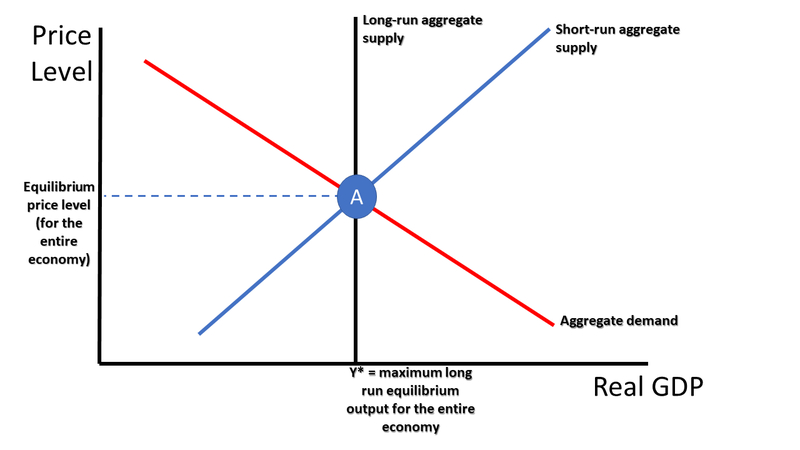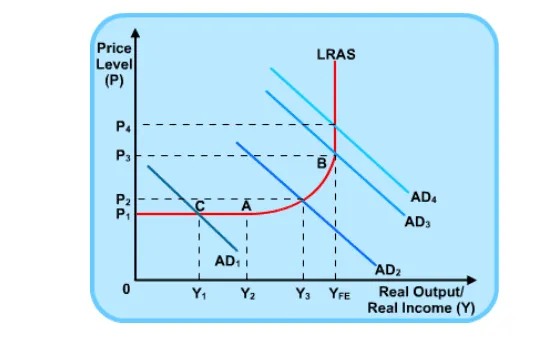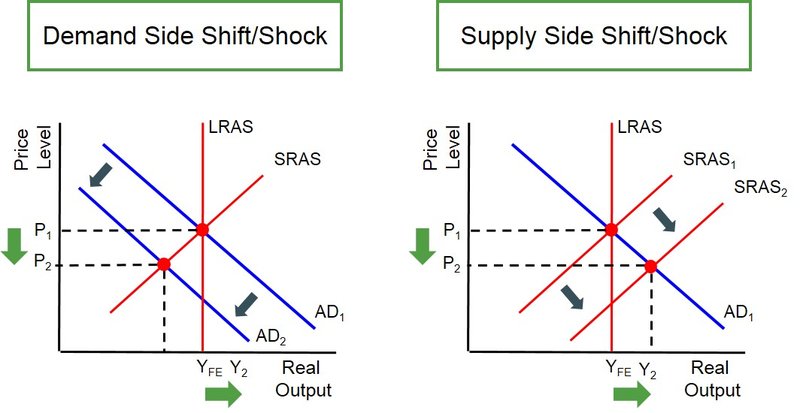Aggregate Supply
- Aggregate supply, similar to aggregate demand, is the macroeconomic equivalent of supply.
- It represents the total output that firms will produce and sell at a given average price level in a certain time period.
- It is split into long-run and short-run aggregate supply when using the neoclassical model.
Short-Run Aggregate Supply (SRAS)
- Total quantity of real output (real GDP) offered at different possible price levels in the short run.
- It slopes upward similar to a normal supply curve.
Shifters of SRAS
- The shifters of the SRAS curve generally occur due to the movement of the AD curve, but factors such as government policies can also cause a shift in the curve.
Costs and Availability of Resources
- A change in wage rates. An increase in wages causes increased production costs and shifts SRAS left, and vice versa.
- A change in the costs of raw materials. Increase in costs shifts SRAS to the left and a decrease shifts SRAS to the right.
- A change in the price of imports. An increase in import prices will decrease SRAS, depending on how many firms use imported materials in production. A decrease in import prices causes SRAS to shift right.
Government Intervention
- A change in government indirect taxes or subsidies. Subsidies increase SRAS and taxes decrease SRAS.
- Regulations can positively or negatively affect producers.
Supply Shocks
- An event that drastically alters supply such as a natural disaster or war.
- Usually results in a drastic leftward shift of the SRAS curve.
Long-Run Aggregate Supply (LRAS)
- Aggregate supply that is dependent upon the resources and technology in the economy, thus being dependent on the price level.
- It is a vertical line at the level of potential output.
- It can only be increased by improvements in the quantity and/or quality of factors of production as well as improved technology.
Graphs
- Short-Run Aggregate Supply Graph
- Similar to a normal supply graph in microeconomics.
- SRAS is an upward sloping curve.
- Price level in Y-axis and real GDP or equivalent in x-axis.
- LRAS is a vertical curve that cuts through the equilibrium.

Shifters of LRAS
- The shifters of LRAS are similar to the shifters of a PPC curve, as both represent the possible economic output of a nation.
- Change in quality or quantities of factors of production
- Technological improvements
- Increase in efficiency
- Changes in institution
Factors That Influence the Quality/Quantity of Factors of Production
- The factors of production are land, labor and capital and entrepreneurship.
Land
Increase in Quantity
- Land reclamation
- Increased access to supply of resources
- Discovery of new resources
Increase in Quality
- Technological advancements that allow for increased access to resources or the discovery of new resources.
- Fertilizers
- Irrigation
Labor + Entrepreneurship
Increase in Quantity
- Increase in birth rate
- Immigration
- Decrease in the natural rate of unemployment
Increase in Quality
- Education
- Training
- Re-training
- Apprenticeship programs
Capital
Increase in Quantity
- Investment
Increase in Quality
- Technological advancements that contribute to more efficient capital
- Research and development
Natural Rate of Unemployment
- The rate of unemployment that occurs when the economy is producing at its potential output or full employment level of output (Yf).
- Natural unemployment exists because there is still some unemployment at the full employment.
- Some people might be switching jobs, or be in training for example.
SRAS Non-Price Determinants
Neoclassical Model of Aggregate Supply
- Neoclassical economics was founded by Milton Friedman in the 1870s.
- General equilibrium approach is based on the school of neo-classical economics.
- Assumes prices are always flexible in the long-run.
- This diagram didn't do well at prediction as prices and wages tend to be less flexible.
- Enforces the idea that the market will fix it self and return to equilibrum (full employment).
- In the neoclassical model, the supply curve will move in response to changes so that LRAS is always cutting through the equilibrium.
Keynesian Model of Aggregate Supply
- Founded by John Manyard Keynes in the 1920s/30s.
- The Keynesian model was a response to the neo-classical models which couldn't fix the great depression.
- States that wages are "sticky" and are slow to change due to labour laws, contracts, salaries, etc.
- Argues that the economy gets stuck in a short-run position.
Only one aggregate supply curve, no distinction between LRAS and SRAS.
Keynesian Aggregate Supply Graph

- Capacity: Maximum level of output possible.
- The Keynesian model has 3 phases.
- The Keynesian model has one AS curve that starts horizontally then curves vertically.
Horizontal Section
- A fair amount of spare capacity. Room to increase GDP without price level going up.
Upwards Sloping Section
- The graph starts to curve upwards as it transitions to the vertical section from the horizontal section.
- Still some spare capacity, yet competition for scarce resources begin.
Vertical Section
- Almost a fully vertical curve.
- Little to no spare capacity. Full employment reached.
- Price increases a lot compared to minor changes in real GDP.
Inflationary and Deflationary Gaps
Recessionary/Deflationary Gap
- When the equilibrium level of real output is less than the potential output as a result of a decrease in AD.
- The gap is the difference between the new aggregate demand curve and the aggregate demand curve at full employment.
- The deflationary gap is temporary.
- The deflationary gap can be seen on a business cycle graph as the difference between actual output and potential output.

Inflationary Gap
- When the equilibrium level of real output exceeds the potential output as a result of an increase in AD.
- The gap is the difference between the new aggregate demand curve and the aggregate demand curve at full employment.
- The inflationary gap is temporary.
- The inflationary gap can be seen on a business cycle graph as the difference between actual output and potential output.

Stagflation and Growth
- Stagflation is a decrease in real GDP and an increase in unemployment rates simultaneously.
- Stagflation is extremely undesirable for an economy.
- Typical growth may also occur in the short run.
Disequilibrium in Aggregate Supply
Short Run Equilibrium
- There can be inflationary or recessionary gaps, but will eventually return to equilibrium.
Long Run Equilibrium
- In the short run, inflationary and recessionary gaps exist.
- However, in the long run, the equilibrium point must return to the LRAS (full employment).
Connection to Business Cycle
- The deflationary gap can be seen on a business cycle graph as the difference between actual output and potential output.
- Graphically, it is the vertical difference between the growth-trend line and the fluctuating actual output line.
- Long term aggregate supply changes as the general growth trend (potential output) increases over time.
- As the economy grows over time, the LRAS curve gradually shifts to the left.
Connection to the PPC Curve
- Points on the PPC curve can show inflationary and deflationary gaps as well.
- A point on the PPC curve is when there is equilibrium and SRAS = LRAS = AD at the GDP at full employment.
- Points below the PPC curve represent a deflationary gap as resources are not at full employment.
- Points above the PPC curve could represent an inflationary gap as resources are beyond full inflation.
- There is a slight discrepancy with this connection, as in a PPC diagram points beyond the curve are said to be impossible.
- The Keynesian model does not share this discrepancy as when there is an inflationary gap AS is perfectly inelastic and therefore output cannot increase alongside increases in demand.
Long-Run Equilibrium Adjustments
AD Decrease
- A decrease in AD results in a decrease in price level across the economy.
- This results in the cost of inputs (such as wages) lowering, allowing companies to hire more workers and therefore increasing SRAS.
- The new price level at the equilibrium is now lower than the original.
AD Increase
- An increase in AD results in an increase in the aggregate price level.
- This results in increased production costs (wages, materials, etc.), leading to a reduction in SRAS.
- The new price level equilibrium is now higher than the original.
Neoclassical vs Keynesian Aggregate Supply.
Neoclassical
Equilibrium
- A market in disequilibrium will always correct naturally.
Wages
- Wages are flexible and can easily change.
Intervention
- Government intervention is not needed.
Keynesian
Equilibrium
- A market in disequilibrium may stay in disequilibrium for extended periods
Wages
- Wages are {"sticky" and do not change easily.
Intervention
- During a recession, the government must increase government spending to correct the recession, even if it must borrow funds.
“But this long run is a misleading guide to current affairs. In the long run we are all dead. Economists set themselves too easy, too useless a task if in tempestuous seasons they can only tell us that when the storm is long past the ocean is flat again.”
J.M. Keynes, 1936.
Sources
https://studymind.co.uk/notes/aggregate-supply-a-level-economics/
https://corporatefinanceinstitute.com/resources/economics/inflationary-gap/
https://www.nuffield.ox.ac.uk/Users/Cameron/lmh/pdf/m8-04.pdf